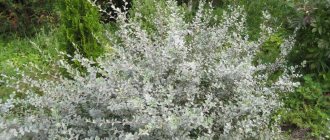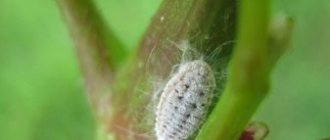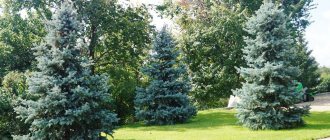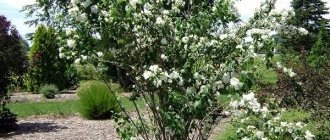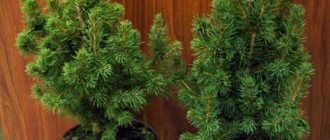Today there are about 170 subspecies of willow. Its Latin name is Salix. This tree is cold-loving and has come to us since the Cretaceous period. Willow grows actively in the northern regions. There are even species that can grow freely near glaciers. Despite the fact that this tree has long been known to man, it is often used in landscape design as one of the main components. In particular, I would like to mention the purple willow nana. It goes well with other types of trees and shrubs, and the crown lends itself well to trimming to give it volume and the desired shape.
Willow nana in landscape design
Purple nana willow (Salix purpurea) or yellow willow, as well as red willow, as a rule, has a natural round shape. It belongs to deciduous shrubs with numerous shoots and small leaves with a silvery tint. The shrub reaches a height of one and a half to four meters. The species was named purple due to the slight red tint of the foliage and bark, as well as its interesting coloring during the flowering period.
This species is especially loved by landscape designers, as the tree is resistant to pruning . This subspecies contains the weeping form Pendula. With its help you can create interesting solutions and add unusual decor options. By mixing willow species, you can create unusual garden design combinations. For example, bush forms with spreading and bushes and creeping species will look good.
Dwarf willows are used to create rock gardens and to give additional relief and volume to the space. Shrubs look good in rocky gardens and near artificial lakes. In combination with trees of different heights they create successful compositions. Willow contrasts very well with flat lawn spaces.
Features during the flowering period
In Europe, special varieties of this species have been grown, which are specifically designed for planting in landscapes and garden plots. The reason for this popularity is its compactness. Willows bloom very beautifully. And although the flowers of this type of nana are not as pronounced as other forms, they still add splendor in their own way in the spring.

This variety is memorable for its long lanceolate leaves up to 15 centimeters. The bark of the tree has different shades of purple, and slightly silvered leaves give it a special mood.
Creating hedges from Nana purpurea willow
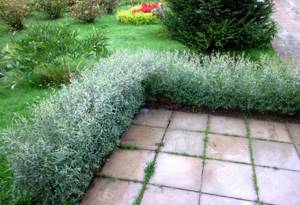
The Nana variety, depending on the subspecies, branches well. Thanks to this quality, you can create a dense, dense green border. The shape can be left natural free or a shaping haircut can be used. The result will be a hedge up to two to two and a half meters in height.
Decorating the landscape with trees and bushes Nana purpurea willow
Willow nana can reach a height of up to four and a half meters. The branches of the tree are lowered down. Each branch is long, and the leaves, with shades ranging from dark green to bluish, are pendulous. By adding such a tree to your landscape design, you can create smooth shapes and smooth out the area. And by using bush forms with a smooth lawn, you can create a classic landscape.
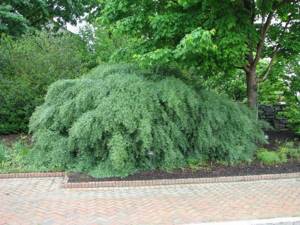
Disease and pest control
The plant is very resistant to various diseases, but some of them can still affect the bush. These include:
With powdery mildew, a white coating appears on the leaves of the plant. Bushes are treated using fungicides. When the weather is too wet, the leaves begin to turn black and then die completely. These are the first signs of scab disease. The affected areas of the plant are removed, and the bush is treated with a fungicide.
Rust is a fungal disease of leaves . It can be identified by the appearance of red spots. The affected parts of the plant are removed and must be burned. Among the pests, it is worth noting the willow moth, leaf beetle and silkworm. Caterpillars of the moth butterfly eat the leaves of a bush. To combat them, insecticides are sprayed.
The leaves are also eaten by leaf beetles. For the winter, these beetles burrow into the ground near plants. Therefore, it is recommended to burn straw and old leaves in these places. Silkworm butterflies lay eggs on the leaves of bushes. The emerging caterpillars destroy all green growth. To combat them, it is recommended to attract sparrows and bats or collect the pest manually. With good care, willow grows into a very beautiful, decorative bush, which can be used as a hedge or to strengthen the banks of a reservoir. It will decorate any area.
Purple willow nana is a low, rounded ornamental shrub. Due to its small size and unusual appearance, it is very popular in landscape design.
Compatibility with other plants and interior items
Willow has its own character. A light purple tint combined with bright, lush greenery provides a certain contrast in the landscape. Therefore, willow nana is best combined with flowers, lawn and coniferous trees. The only thing is that gardeners do not recommend planting willow and any other trees, as well as shrubs next to walnut and birch. These are quite powerful varieties. They have a bad impact on any green neighbors.
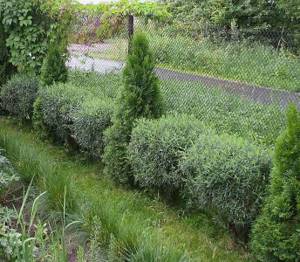
Willow and interior
Recently, willow can be found quite often in home interiors. Its branches not only decorate the room, but are also depicted in paintings and objects. Nana willow branches tend to be stored for a long time when dried. The most suitable period for collecting branches is when a tree or bush is flowering. This way they will look better. When dried, they can last for a year. Home interior designers can also further decorate the branches by covering them with silver or gold paint. This way you can create a New Year and Christmas mood.

Due to its plasticity, willow can be woven into unusual decorative elements. The branches go well with ribbons and clear glass.
Plant care
Purple willow, described above, does not require much time. Maintenance is quite simple, the main condition is regular watering.
Light
The shrub loves bright, diffused light. The best location is under bright sun, where the sun hits the ground for at least 6-8 hours a day. It can also bloom in partial shade, but the crown will be less lush and bright. If you plant the plant in full shade, the shoots will reach towards the sun. Such conditions create an untidy appearance for the plant.
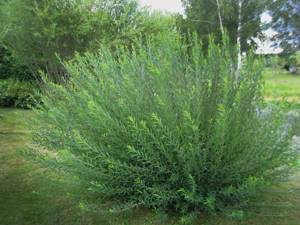
Soil for plants
Prefers neutral acidity of the soil. But it can grow in any soil. If the soil is dominated by clay and heavy textures, it is better to lay out a drainage layer of pebbles and sand. Does not like the proximity of groundwater to the root system.
Twice a month you can loosen the soil to a depth of 10 cm. This will help oxygen better nourish the root system and accelerate growth.
Watering willow
Watering must be done regularly. The plant does not like drought. It is important not only to shed the roots with settled water, but also to spray the bush from above.

Fertilizers
Young plants need feeding. Nitroammophoska will do. The mixture will help the bush create a lush green crown. To avoid infection by small insects, the bush is pre-treated with a solution of insect repellent and fungal infection.
Planting a plant
A hole is dug under the root system. It is moistened with 5-6 liters of water. Then the seedling is placed and covered with soil. The soil may consist of peat, sand and compost. After planting, the plant is watered again from above with a volume of 10-15 liters.

They care for the young shoot in the same way as for an adult shrub. When planting a hedge, leave a distance of 1.3-1.5 m between plants. Before creating a hedge, the soil is dug up. This is not required for single landings.
Subspecies and varieties of willow nana purpurea
Willow is quite diverse in the existence of subspecies. Of these, four main forms can be distinguished:
Salix purpurea "Nana" - this species can be characterized by thinner shoots and small miniature bush sizes. The natural shape is semi-round. The leaves have a light silvery tint. The height does not exceed one and a half meters in height and two meters in diameter. Flowering begins between March and April. It is photophilous, can withstand drought, but prefers moist places.
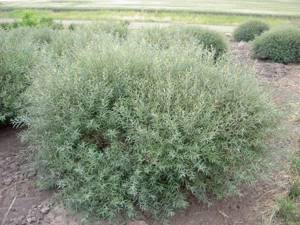
Salix purpurea "Nana"
Application in landscape design - designing a site in flooded parts, to create hedges and give geometry and shapes, and also serves to strengthen the shoreline of a reservoir.
Purple weeping willow . This subspecies differs from others in that the tree looks more elegant. Willow looks like a small round bush with elongated bluish leaves. The foliage is quite dense. The crown is drooping, which is why it is called weeping.
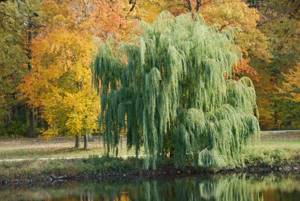
Purple weeping willow
Application in landscape design - this variety looks organically near rivers, lakes and artificial reservoirs. This adds romance and tenderness to the landscape. Very often it is the weeping willow that becomes the basis of the composition. The tree looks great in tandem with shrubs and conifers. Due to its tolerance to temperature conditions and different humidity levels, the tree can be found in urban flower beds.
"Pendula" - has an elegant crown. Foliage color is light green blue. The bush is refined, with smooth lines, flexible branches with a slight purple tint. When willow flowers, large anthers are formed. The tree is resistant to both drought and high humidity.
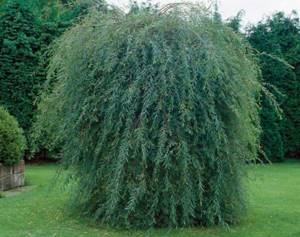
"Pendula"
Application in landscape design - this form is used in solitary plantings and to create a composition of shrubs and trees of different shapes and heights.
Willow Salix Purpurea "Glacillus" . This willow does not reach a height of more than one meter. Has the shape of a ball. The crown is dense and grows up to one and a half meters in diameter. Thanks to its thin leaves and light bluish tint, the bush acquires a delicate silhouette. With the right haircut, it becomes like a cloud. This form of willow is best planted in large open spaces. In order for the crown to be as large as possible, the bush must be pruned in the spring.
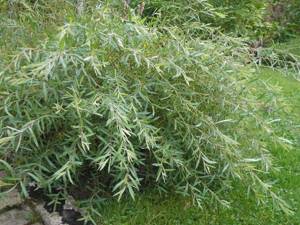
Willow Salix Purpurea "Glacillus"
Application in landscape design - planted on alpine hills, as a soletaire for lawns and to create green hedges. Goes well with coniferous trees and shrubs. Ideal for planting in large areas to decorate the landscape.
Planting seedlings in open ground
Purple willow can be planted almost throughout the season, but is best done in the spring. First, choose a location on the site. It must be light, and partial shade is also suitable. These plants do not grow in the shade, even in the wild. Having chosen a place for planting, they begin to prepare the soil cover.
If the plants will be used as single plantings, then the soil does not need to be dug up, but for a hedge, a strip of at least one meter wide should be dug up. Next, holes are prepared for each plant with a diameter of 0.5 m and a depth of 0.4 m. If the seedling is planted with seedling soil, then the size of the hole should correspond to the earthen coma.
A drainage layer of broken bricks or stones is laid at the bottom of the pit. A mixture of sand, peat and compost is poured on top, and fertilizer containing nitrogen is also applied. Carefully place the seedling in the hole and add the remaining soil. The soil around the seedling is compacted to form a pit for irrigation. 20 liters of warm water are poured under the young plant.
Willow purple nana - care and reproduction
Trees after two years of age, as a rule, do not tolerate transplantation well. But younger ones are pleased with their environmental sustainability. You can grow willow yourself. The main thing when planting it is to avoid places with standing groundwater. When planting cuttings or stakes, it is recommended to make a trench about centimeters wide. The distance between the cuttings in a row should be approximately fifteen centimeters.
It is worth considering that willow tolerates being in close proximity to lawn grass and other plants. Only leek is destructive for her. To prevent the willow from getting sick, fallen leaves must be removed in the fall.
As for willow grown in nurseries, the Nana purpurea subspecies of willow takes root well in the shade under the canopy of trees, although the tree is considered light-loving. Willow requires constant watering, as it loves moisture. But there should not be too much water. The durability of the tree is up to thirty years of life.
Willow will always remain popular in landscape design. The tree is unpretentious and pliable for shaping and creating branched compositions. It is not for nothing that in England willow was used to decorate palace grounds for many centuries in a row. Wood is still considered an undeniable classic in landscape design today. Today, the use of willow in Russia is experiencing a certain stage of revival, which is well deserved for this species. Therefore, it plays one of the central preferences when choosing the design of a garden, a country flower garden, to complement an artificial lake and landscape in various styles.
Propagation by cuttings
The main method of growing willow, besides pendula, is propagation by cuttings. You can also grow shrubs from seeds. But the fact is that their viability lasts only one week and their germination rate is very low. Cuttings are usually harvested in the spring, before the leaves appear, when the plant does not yet secrete a large amount of sap. For this process, specimens older than two years are selected .
Blanks 15-20 cm long are cut from the branches with a sharp knife. There must be from 5 to 7 buds on them. The top cut should be straight, and the bottom cut should be at 45°. Next, you need to germinate the cuttings, which can be done at home or in a greenhouse. Germination is carried out in several ways. The simplest is to place the blanks in a jar of water until the roots appear.
Some gardeners plant the cuttings in a box with wet sand, so that no more than two buds remain on the surface. This method is also used for autumn cuttings. In this case, the sand should be constantly watered so that it is wet all the time. Many gardeners recommend not to rush to plant seedlings in open ground.
First, the root system of the young plant needs to become stronger. To do this, prepare separate containers for each cutting and fill them with special soil for seedlings. The fact is that this soil contains all the necessary components for the development of a young plant. The seedlings end up completely ready for planting in open ground.


